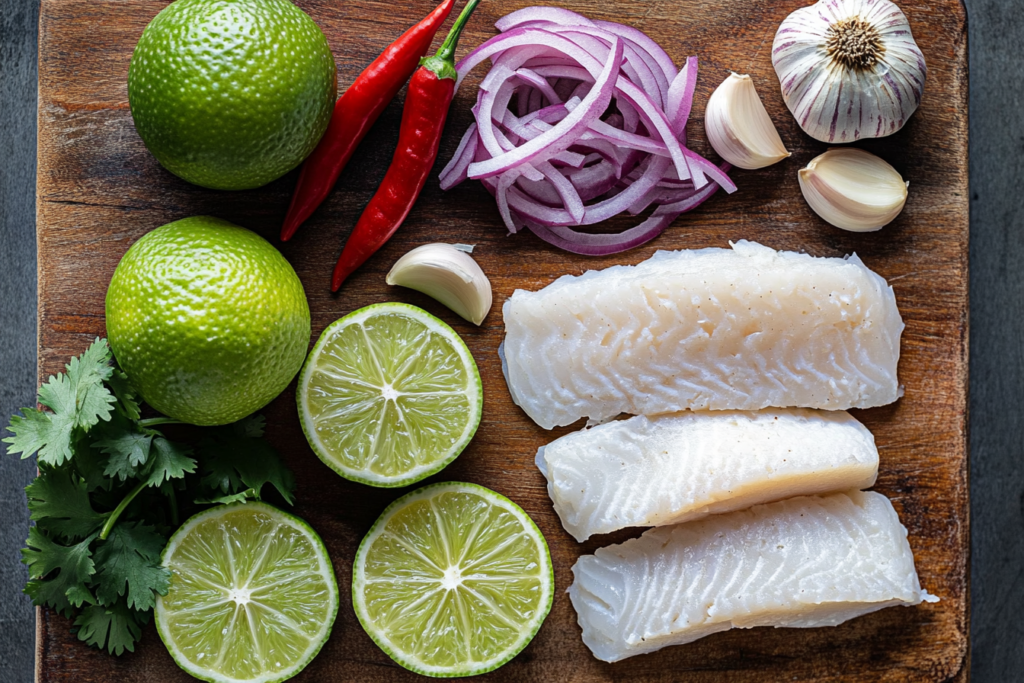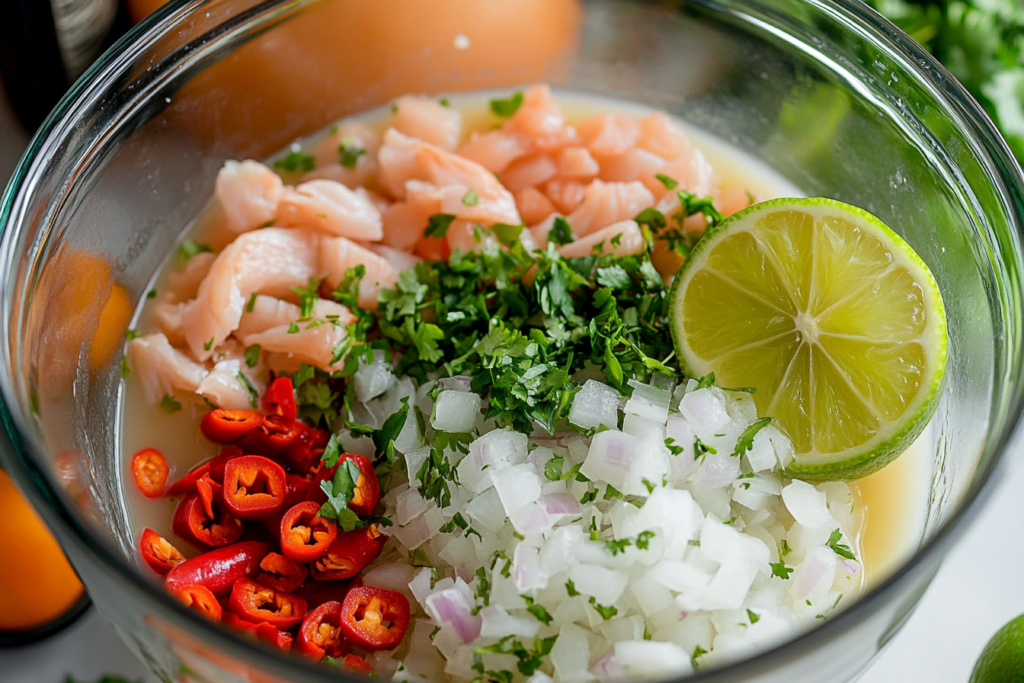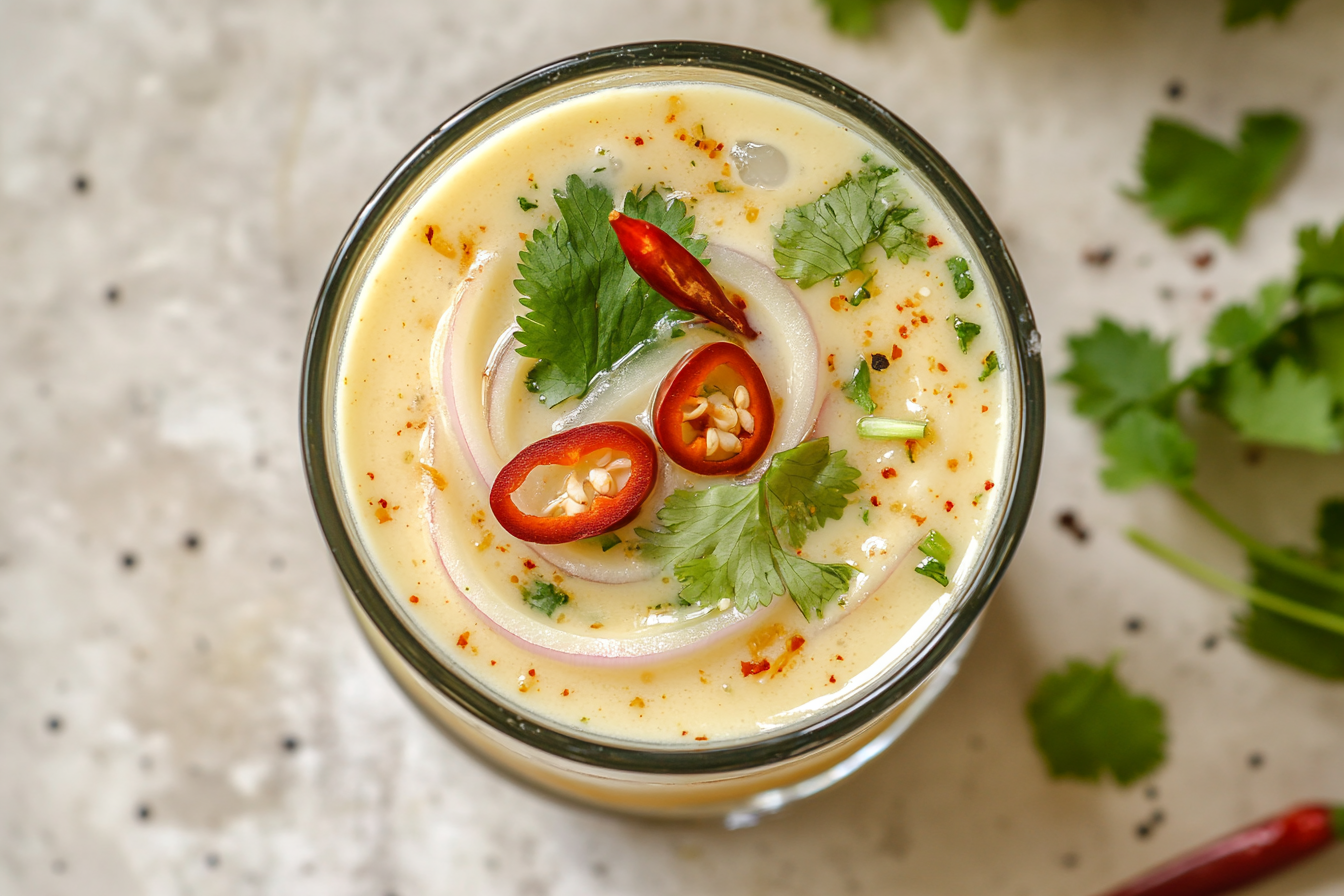Enjoy this iconic Peruvian marinade that elevates seafood and other dishes, featuring bold flavors and a zesty kick you’ll love.
Introduction and Historical Background
Peru boasts many famous culinary treasures, albeit leche de tigre recipe stands out among the best. This zesty marinade pairs perfectly with an array of seafood. Also, it plays a key role in elevating ceviche and other raw or lightly cooked fish preparations. According to Smithsonian Magazine, Peruvian cuisine stems from centuries of cultural exchange between indigenous populations, Spanish colonizers, and Asian immigrants.
Comparatively, leche de tigre recipe holds deep roots in coastal communities. First, locals discovered that mixing citrus juice, chilies, and fresh herbs accentuated fish flavors. Secondly, the marinade’s vibrant taste became symbolic of Peruvian identity.
Moving forward to the next topic, let us examine the marinade’s journey from humble fishing villages to modern kitchens. Afterward, you will understand how its flavors evolved into the exhilarating mixture we love today.
Understanding Leche de Tigre
Certainly, leche de tigre recipe is much more than citrus and peppers. It is a concentrate of tangy, spicy, and savory elements. Nonetheless, many presume it to be solely fish-infused lime juice. However, it merges multiple aromatics, giving your palate bursts of robust flavor.
Definition of Leche de Tigre
The term “tiger’s milk” might sound intimidating. Nevertheless, it carries a playful connotation that hints at the marinade’s vibrant color and lively kick. Traditionally, chefs rely on fresh fish, lime juice, onion, garlic, and chili peppers. Additionally, cilantro and other herbs frequently appear, giving the mixture a bright green hue. While it forms the base for ceviche, you can also enjoy it as a stand-alone shot or drizzle it over grilled meats.
Key Components and Essential Flavors
The fundamental taste trifecta arises from acidity, heat, and salt. First and foremost, the freshly squeezed lime juice’s sharpness awakens taste buds. Secondly, hot peppers add that exhilarating punch. Thirdly, salt balances everything, preserving the flavors while enhancing them. Formerly, the recipe was restricted to local ingredients. Now, global markets give you a broader scope of peppers and herbs.
Common Misconceptions
People often assume leche de tigre recipe must use fish stock or fish trimmings. In reality, the marinade can be purely citrus-based with no added seafood. Though fish or shellfish juices impart extra savoriness, you can still achieve an authentic taste without them. Another misunderstanding revolves around spiciness. While many versions are spicy, you can certainly adjust chili levels to suit your tolerance.
Heading into the subsequent area, let us examine the integral components of this beloved marinade.
Primary Ingredients and Selection

Fundamentally, leche de tigre recipe relies on fresh, high-quality produce. If you compromise on ingredient quality, the result will not shine. Hence, it is crucial to select the best seafood, citrus, and aromatics.
Seafood Choices for Optimal Taste
Any fish that is firm-fleshed and mild in flavor works well. Commonly, corvina, sea bass, or grouper feature in classic preparations. Though, shrimp provides a sweet twist, especially when adding body to the marinade. Some adventurous cooks add scallops or a mix of different sea creatures. Notwithstanding your choice, make sure the seafood is impeccably fresh to avoid any off flavors.
Citrus Selection
Traditionally, Peruvian limes, known as “limón sutil,” deliver the signature tang. However, they may be difficult to find outside Peru. Therefore, small, thin-skinned key limes or regular limes typically serve as good substitutes. Occasionally, a blend of lime and lemon provides an interesting dimension. Lest the lime supply is short, mix lemon juice with a splash of grapefruit or orange for a balanced acidity.
Aromatics
Red onion is essential for its subtle sweetness and sharp snap. But other onion varieties can work, though they alter the flavor slightly. Garlic adds depth, while chili peppers such as aji limo or rocoto supply heat. Also, fresh cilantro or parsley injects a bright herbal note. Further, a pinch of ginger can boost complexity.
Herbs and Spices
Salt and pepper remain the main seasoning agents. Yet, some cooks experiment with cumin or oregano. Another option is to add a tiny bit of fresh celery for an aromatic boost. Similarly, you may add a dash of fish sauce for an umami lift. Summarily, the ratio of these herbs and spices can be adapted to personal preference.
In the next phase, let us explore how these components also offer nutritional benefits.
Health Benefits and Nutritional Insights
Markedly, leche de tigre recipe can be quite healthy when prepared with fresh, whole ingredients. The marinade’s acidic nature lightens your palate, while the added spices spur metabolism.
Vitamin C from Citrus Fruits
Citrus juices are abundant in vitamin C, which supports immune function. Additionally, this essential vitamin aids collagen production and iron absorption. Because the marinade uses ample amounts of lime juice, it can boost the nutritional value of your meal.
Protein and Minerals from Seafood Additions
In many recipes, fish or shrimp is blended into the marinade. This significantly increases the protein content. Consequently, you consume valuable minerals such as selenium and iodine. Thus, this dish can be part of a balanced diet, especially if you watch your caloric intake.
Low-Fat, High-Flavor Marinade Option
Unlike cream-based dressings, leche de tigre recipe keeps fat content minimal. Generally, any fat comes from fish fillets or slight amounts of oil, if used. Therefore, the dish remains relatively light while maintaining a bold taste.
Role in Digestion and Appetite Stimulation
The high acidity stimulates saliva production. Indeed, it activates digestive processes in the stomach. Also, spicy peppers can ignite metabolism, albeit everyone’s tolerance differs. Overall, the marinade’s fresh zest can energize you, especially when you crave a tangy dish.
In the next subsection, we delve into the detailed procedure of crafting this cherished Peruvian specialty.
Step-by-Step Preparation

Overall, making leche de tigre recipe is straightforward if you follow a structured approach. Although variations exist, the procedure stays consistent: gather, blend, taste, and serve.
Equipment and Tools Needed
- Sharp chef’s knife for chopping
- Cutting board
- Citrus juicer (handheld or electric)
- Mixing bowls
- Fine mesh strainer (optional)
- Blender or food processor (if using fish or shrimp in the marinade)
Proper Cleaning and Prepping of Seafood
First, choose the highest-grade, freshest fish available. If using shrimp, remove shells and veins. Then, rinse them briefly under cold water. Pat everything dry with paper towels. Doing so eliminates extra moisture that could dilute the marinade. Before blending the seafood into the mixture, ensure you dice it into small chunks.
Creating the Citrus Base
Secondly, squeeze fresh limes until you have enough juice for the recipe. Typically, you need about one cup of lime juice for a small batch serving four people. If you need to cut the sourness, add a small splash of orange juice. Also, taste as you go. Because certain limes are tarter than others, you might adjust accordingly.
Combining Aromatics and Herbs
Thirdly, slice your onions into thin strips or small cubes, depending on your texture preference. Emphatically, do not skip rinsing the onions in cold water if they taste too sharp. Then, chop or crush garlic, dice chili peppers, and tear fresh cilantro leaves. Place them into a bowl with the lime juice.
Afterward, if you plan to incorporate fish chunks or shrimp scraps, add them now. Blend or pulse gently if you want a thicker consistency. Otherwise, you can keep the marinade chunky.
Final Tasting, Adjusting Spices, and Resting Time
Season with salt, pepper, and any additional spices. Correspondingly, keep tasting. Chefs in Peru advise letting the marinade rest for about 10 minutes to let flavors meld. However, do not wait too long. The ideal moment is when the marinade still has a sharp tang but also a balanced overall flavor.
Shifting to the next part, let us explore creative spins you can try for your next Peruvian feast.
Leche de Tigre Variations
Altogether, the classic approach is sublime, but you can modify leche de tigre recipe in numerous ways. Fundamentally, these variations keep the zest intact while adding intriguing new elements.
Classic Peruvian Style with Fresh White Fish
Consider this the baseline recipe. You use white fish, lime juice, onion, garlic, chili peppers, salt, pepper, and cilantro. The result is a bright, aromatic marinade perfect for ceviche or sipping by itself.
Spicy Approach with Rocoto Pepper or Habanero
For those who appreciate fiery heat, opt for rocoto peppers. They have a distinct flavor that merges well with the citrus base. Alternatively, habanero peppers offer a floral yet sharp spice that lingers on the palate. Surely, handle these peppers with care to avoid burning your eyes or skin.
Shrimp-Infused Leche de Tigre
Adding raw shrimp or shrimp shells to the blend provides a sweet undertone. Indeed, this is popular along Peru’s northern coast, where shrimp abounds. You may want to strain out larger pieces if you prefer a smooth marinade.
Vegan or Vegetarian Alternatives
Notwithstanding the traditional emphasis on seafood, you can use vegetable stock or a combination of mushrooms and tomatoes for umami. Also, hearts of palm or artichoke hearts can replace fish. The lime-based marinade remains the same. Just omit any fish-based ingredients.
On to the following discussion, we will explore ways to serve and pair this zesty concoction with other foods.
Serving Suggestions and Pairings
But how exactly should you present leche de tigre recipe? Generally, Peruvians serve it in small glasses or shot glasses as a palate cleanser before a meal. Another popular method is to drizzle it over fresh seafood.
Presentation Tips
Concurrently, keep your marinade chilled until serving. Garish the glass edges with a thin slice of chili or a lime wedge. Also, set out small spoons so guests can sip or spoon it easily. Present it as part of a seafood platter for a chic, upscale flair.
Paired Side Dishes
Peru’s classic accompaniments include boiled choclo (large-kernel corn), sweet potato, or yuca. The sweetness of these starches contrasts with the marinade’s acidity. Comparatively, you can also serve crispy plantain chips or toasted corn kernels to add crunch.
Beverage Pairings
During warm summer days, a cold Peruvian beer such as Cusqueña or Pilsen complements the marinade’s spice. Alternatively, you can serve non-alcoholic chicha morada (a purple corn drink) for a fruity pairing. If you prefer cocktails, a Pisco Sour echoes the lime’s zing.
Using as a Ceviche Marinade or Sauce
Often, people use leche de tigre recipe to marinate raw fish for ceviche. Let the fish absorb the flavors for a few minutes, then serve promptly. Likewise, pour it atop grilled shrimp or octopus as a finishing sauce. Certainly, you can experiment with different proteins or vegetables.
Advancing to the next topic, let us address storage and shelf-life details.
Storage and Shelf-Life
It is best to consume leche de tigre recipe immediately or shortly after preparation, especially if raw seafood is part of the mix. Nevertheless, there are ways to store leftovers safely.
Short-Term Storage
Place leftover marinade in an airtight container and store in the refrigerator. Ideally, use it within 24 hours. If you plan to drink it on its own, give it a quick stir before serving to recombine any settled ingredients.
Safe Handling and Refrigeration Guidelines
Ensure that your marinade remains under 40°F (4°C). Because the recipe contains raw or partially cooked seafood, ignoring safe storage can lead to bacterial growth. Markedly, good kitchen hygiene is crucial.
Freezing Recommendations
Freezing leche de tigre recipe may diminish its fresh flavor. However, you can freeze it if you plan to use it as a soup base or cooking liquid later on. Be sure to store it in a freezer-safe container, leaving some headspace for expansion. Thaw gently in the fridge. Bear in mind the citrus might become slightly bitter after prolonged freezing.
Continuing in the following part, we will cover common pitfalls that newcomers often face when trying out this recipe.
Common Mistakes to Avoid
Occasionally, mishaps happen if you lack experience with Peruvian cooking or if you hurry the process. Here are some tips to steer clear of errors.
- Over-Marinating Seafood
Some cooks let the fish sit for too long, resulting in rubbery texture. Comparatively, a short marinating period yields a better mouthfeel. - Using Poor-Quality Ingredients
Because leche de tigre recipe is predominantly uncooked, freshness is paramount. Low-grade fish or stale limes will ruin the dish. - Rushing the Resting Time
Conversely, some skip letting flavors meld. A quick rest of around 10 minutes ensures the onions, chilies, and citrus integrate effectively. - Forgetting to Taste Throughout
During every stage, taste your marinade. Adjust chili peppers, salt, or herbs as necessary. Otherwise, you risk an unbalanced final result.
Transitioning into the following chapter, let us explore the broader cultural influence of this marinade and how it intersects with other global cuisines.
Regional Takes and Global Influence
Despite being rooted in Peruvian tradition, leche de tigre recipe resonates with foodies worldwide. Previously confined to local markets, it now stars in global gourmet circles.
Influence in Various Latin American Cuisines
Nations like Ecuador and Chile have their own citrus-based fish marinades. Correspondingly, variations on tiradito and ceviche reflect the marinade’s strong impact. Also, chefs throughout the region experiment with local peppers, from mild to fiery.
Fusion Trends in North America and Europe
Chefs in the U.S. and Europe incorporate leche de tigre recipe into diverse dishes. Some drizzle it over raw oysters, while others integrate it into fusion sushi rolls. Consequently, the marinade’s popularity crosses cultural boundaries.
Adaptations in Modern Gourmet Restaurants
Because of its intense flavor, top culinary artists frequently reimagine leche de tigre recipe for tasting menus. You might spot it served in a small dish as a “shot,” garnished with microgreens or edible flowers. Indeed, the marinade’s tang can contrast with rich or fatty items, balancing an entire course.
In the ensuing segment, we move on to a set of frequently asked questions that often arise among those new to this vibrant marinade.
Frequently Asked Questions (FAQs)
1. What is leche de tigre made of?
Leche de tigre recipe traditionally features fresh lime juice, chili peppers, garlic, onion, salt, pepper, and a bit of fish or shrimp. However, you can skip seafood if you prefer a vegetarian-friendly marinade.
2. What is tiger milk made of?
Tiger milk is the English translation for this Peruvian marinade. It includes the same core ingredients: citrus juice, spicy peppers, aromatics, and sometimes fish-based stock.
3. What is the difference between ceviche and leche de tigre?
Ceviche is a dish made with raw fish or seafood marinated in citrus juice. Leche de tigre recipe refers specifically to the citrus-based liquid marinade itself. It is commonly served as a standalone drink or sauce.
4. What does leche de tigre taste like?
It tastes bright, tangy, and slightly spicy. The citrus delivers an acidic punch, while the peppers add heat. Onion and garlic impart savoriness. Altogether, it is both refreshing and bold.
Heading into the subsequent area, let us recap the highlights and emphasize why leche de tigre recipe deserves a spot in your cooking repertoire.
Conclusion
Undoubtedly, leche de tigre recipe illustrates the culinary spirit of Peru. It harnesses fresh ingredients to create a marinade that is tangy, spicy, and utterly delicious. First, you learned that the recipe demands quality produce. Second, you discovered the wealth of health benefits inherent in citrus juices and seafood proteins. Thirdly, we delved into how to prepare it step by step, ensuring each component harmonizes perfectly.
Certainly, you can experiment with spicier peppers or milder herbs. You can adapt the marinade to vegetarian preferences or use it to enrich grilled meats. Ultimately, the marinade’s versatility shines. Therefore, whether you enjoy it as a shot, a ceviche base, or a topping for your favorite dish, you will relish the burst of flavor. So, gather your fresh ingredients, follow the tips outlined here, and embark on a taste adventure that will transport you to the vibrant Peruvian coast

